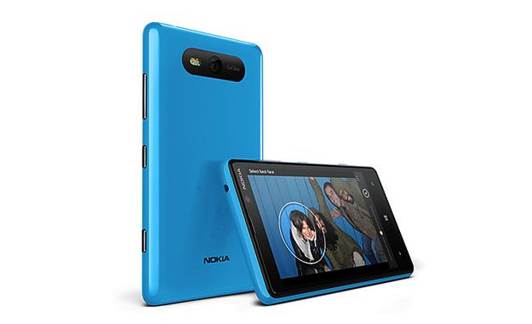Nokia’s affordable Windows Phone 8
device is a well-balanced and powerful handset
Nokia made a splash with its first Windows
Phone 8 handset, but despite its talents, the Lumia 920 was bulky, battery life
was below average and it was too expensive. Nokia has addressed these concerns
with the Lumia 820, a mid-range phone that’s trimmer and lighter and much
better for it.

The
panel’s highly saturated colors pop right off the screen
The downsizing doesn’t bring Nokia’s new
unit into line with the 131g Samsung Galaxy S III, but the 820’s 9.9mm girth
and 160g weight are far more manageable than the 10.7mm, 185g Lumia 920. It
isn’t the chore to hold or cram into a pocket in the way the 920 is, and the
hard, matte finish and rounded corners lend it a comfortable, premium feel.
The latest Lumia beats its stablemate for
versatility, too. While the 920 was milled from a single block of polycarbonate
with no internal access, the entire casing (including buttons) of the 820 is
removable, granting access to the battery and both micro-SIM and microSD card
slots.
That “shell” is also replaceable, with six
different colors available, priced at around $30 each. Each one includes a
patch that allows the phone to be charged wirelessly via Nokia’s inductive
charging plate ($75). Nokia says a rugged shell will be available later this
year.

The 820 is as sturdy and attractive as its
bigger brother, then, but it’s clearly a mid-range handset. The display is a
4.3in unit and resolution is a mere 480 x 800 pixels; it feels outdated beside
the Lumia 920’s 4.5in, 768 x 1,280 screen, with app icons, text and images
lacking the sharpness we’ve become used to on recent high-end phones.
Nokia has also used a different panel
technology for the 820 – AMOLED and the difference is obvious when you line it
up next to the 920, which uses an IPS panel. The 820’s highly saturated colors
give it the edge on brightly covered graphics, but the larger Lumia’s more
muted, realistic tones are better for viewing photographs and video.
Furthermore, while the 820’s panel has perfect black levels, it tends to crush
darker colors together. The Lumia 920 does a better job of handling subtle
tones at the extremes of the color spectrum. There’s no difference in the
internal hardware, though, and the 820’s components don’t disappoint. The
1.5GHz dual-core Snapdragon processor, Adreno 225 graphics chip and 1GB of RAM
helped the phone score 906ms in the SunSpider JavaScript benchmark, in the same
ball park as the 920ms scored by the Lumia 920. Both results are the fastest
we’ve seen from any phone.

The
Lumia 820’s casing is removable, giving access to the battery
In real-world use, the 820 performed near-
flawlessly. It ran games without any frame-rate issues, and Windows Phone 8 was
almost as slick. There was a tiny judder when switching from the homescreen to
the alphabetical list of apps, but this is a small complaint.
Other specifications comprise dual-band
802.11n Wi-Fi and Bluetooth 3.1, with NFC and LTE rounding things off. We’d
prefer more storage than the miserly 8GB, and a bigger battery than the
1,650mAh unit, though. It had 50% remaining after our 24-hour rundown test,
which is better than the 920’s 40% result, but still below average.
Nokia hasn’t brought PureView to the 820’s
8-megapixel camera, and there’s a clear gulf in quality. The 820 captures
sharp, colorful images, but the 920’s incredible camera captured even more
detail with less grain, and excelled in low-light conditions. The lack of
optical image stabilization means 1080p video isn’t as smooth on the 820,
either.
Our fondness for the Windows Phone 8 camera
app remains undimmed, though, with its excellent selection of software
“lenses”, and Nokia includes the same range of valuable software extras as on
the 920. In addition to the core OS, you get Nokia Maps and Drive, plus Nokia
Music and City Lens. Developer support is still patchy, though, with none of
the apps noted in our 920 review – Instagram, Dropbox, iPlayer and Spotify –
yet available in the store.

Other
specifications comprise dual-band 802.11n Wi-Fi and Bluetooth 3.1, with NFC and
LTE rounding things off.
Not only is the Lumia 820 an attractive
smartphone but, if bought on a 3G contract, it offers excellent value for
money, too. At $32 per month, it’s cheaper than the Lumia 920 and Samsung
Galaxy S III on similar deals.
We closed our Lumia 920 review by advising
potential buyers to wait and see what other Windows Phone 8 handsets had to
offer, but we didn’t expect Nokia’s own Lumia 820 to provide the competition.
The low-resolution screen, weaker camera and lack of apps mean that it can’t
compete with the best Android handsets, but the usability of Windows Phone 8
and attractive physical design mean this well-balanced Nokia is still an
attractive proposition.
|
Specifications
§ Price:
SIM-free: 8GB, $474; from free on a $32/mth, 24mth contract
§ Ratings:
5/6
§ Dual-core
1.5GHz Snapdragon S4 Plus
§ 1GB
RAM
§ 8GB
storage
§ 4.3in
480 x 800 AMOLED display
§ Quad-band
GSM/GPRS/EDGE/3G/HSDPA/LTE
§ Bluetooth
3.1
§ Dual-band
802.11n Wi-Fi
§ 8mp
stills
§ 1080p
video
§ 1,650mAh
battery
§ Windows
Phone 8
§ 1yr
RTB warranty
§ 124
x 68 x 9.9mm (WDH)
§ Weights:
160g
|